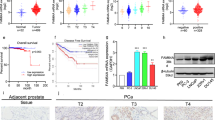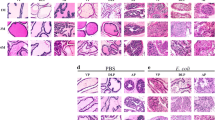Abstract
Treg cells are crucial for maintaining immune homeostasis in CP/CPPS, but the molecular mechanisms underlying the modulation of the function of Treg in CP/CPPS remain unclear. The main purpose of this study is to investigate the relationship between immunosuppressive function of Treg and the methylation level of Foxp3 promoter in experimental autoimmune prostatitis (EAP) mouse model. EAP model was induced by subcutaneous injecting prostate-steroid-binding protein (PSBP) and complete Freund’s adjuvant with NOD mice. Histological analysis revealed that EAP model was successfully induced. The expression of IFN-γ was increased, and TGF-β was decreased in the serum of EAP, respectively. The percentage of Tregs in splenic lymphocyte was increased in EAP. The suppressive ability of Tregs on Teffs was impaired in EAP. The methylation level of Foxp3 promoter was increased, and the expression of Foxp3 was decreased in EAP. By injection AZA which was DNA-methylation inhibitor into EAP mice, prostate inflammation was alleviated, expressions of TGF-β and Foxp3 were increased, and the suppressive function of Tregs was improved in vitro and in vivo. Thus, we concluded that aberrant increased methylation of Foxp3 promoter in Treg cells leads to the impaired suppressive function of Treg cells, exacerbating autoimmune inflammatory injury in EAP.







Similar content being viewed by others
References
Collins, M.M., R.S. Stafford, M.P. O'Leary, and M.J. Barry. 1998. How common is prostatitis? A national survey of physician visits. The Journal of Urology 159 (4): 1224–1228.
Schwartz, E.S., A. Xie, J.H. La, and G.F. Gebhar. 2015. Nociceptive and inflammatory mediator upregulation in a mouse model of chronic prostatitis. Pain 156 (8): 1537–1544.
Rees, J., M. Abrahams, A. Doble, and A. Cooper. 2015. Diagnosis and treatment of chronic bacterial prostatitis and chronic prostatitis/chronic pelvic pain syndrome: a consensus guideline. BJU International 116 (4): 509–525.
Krieger, J.N., L. Nyberg, and J.C. Nickel. 1999. NIH consensus definition and classification of prostatitis. Jama the Journal of the American Medical Association 282 (3): 236–237.
Murphy, S.F., A.J. Schaeffer, and P. Thumbikat. 2014. Immune mediators of chronic pelvic pain syndrome. Nature Reviews Urology 11 (5): 259–269.
Liang, C., H. Li, Z. Wang, J. Xing, W. Hu, and T. Zhang. 2009. The prevalence of prostatitis-like symptoms in China. The Journal of Urology 182 (2): 558–563.
Clemens, J.Q. 2008. Male and female pelvic pain disorders-is it all in their heads? The Journal of Urology 179 (3): 813–814.
Cohen, J.M., A.P. Fagin, E. Hariton, J.R. Niska, M.W. Pierce, A. Kuriyama, J.S. Whelan, J.L. Jackson, and J.D. Dimitrakoff. 2012. Therapeutic intervention for chronic prostatitis/chronic pelvic pain syndrome (CP/CPPS): a systematic review and meta-analysis. PLoS One 7 (8): e41941.
Hu, C., H. Yang, Y. Zhao, X. Chen, Y. Dong, L. Li, Y. Dong, J. Cui, T. Zhu, P. Zheng, C.S. Lin, and J. Dai. 2016. The role of inflammatory cytokines and ERK1/2 signaling in chronic prostatitis/chronic pelvic pain syndrome with related mental health disorders. Scientific Reports 6: 28608.
Breser, M.L., F.C. Salazar, V.E. Rivero, and R.D. Motrich. 2017. Immunological mechanisms underlying chronic pelvic pain and prostate inflammation in chronic pelvic pain syndrome. Frotiers in Immunolgy 8: 898.
Polackwich, A.S., and D.A. Shoskes. 2016. Chronic prostatitis/chronic pelvic pain syndrome: a review of evaluation and therapy. Prostate Cancer and Prostatic Diseases 19: 132–138.
Alexander, R.B., F. Brady, and S. Ponniah. 1997. Autoimmune prostatitis: evidence of T cell reactivity with normal prostatic proteins. Urology 50 (6): 893–899.
Kouiavskaia, D.V., S. Southwood, C.A. Berard, E.N. Klyushnenkova, and R.B. Alexander. 2009. T-cell recognition of prostatic peptides in men with chronic prostatitis/chronic pelvic pain syndrome. The Journal of Urology 182 (5): 2483–2489.
Penna, G., N. Mondaini, S. Amuchastrgui, S.D. Innocenti, M. Carini, et al. 2007. Seminal plasma cytokines and chemokines in prostate inflammation: interleukin 8 as a predictive biomarker in chronic prostatitis/chronic pelvic pain syndrome and benign prostatic hyperplasia. European Urology 51 (2): 524–533.
Ponniah, S., I. Arah, and R.B. Alexander. 2015. PSA is a candidate self-antigen in autoimmune chronic prostatitis/chronic pelvic pain syndrome. Prostate 44 (1): 49–54.
Rivero, V., C. Carnaud, and C.M. Riera. 2002. Prostatein or steroid binding protein (PSBP) induces experimental autoimmune prostatitis (EAP) in NOD mice. Clinical Immunology 105 (2): 176–184.
Motrich, R.D., E.E. Van, F. Baeke, C.M. Riera, C. Mathieu, et al. 2010. Crucial role of interferon-gamma in experimental autoimmune prostatitis. The Journal of Urology 183 (3): 1213–1220.
Breser, M.L., A.C. Lino, R.D. Motrich, G.J. Godoy, J. Demengeot, and V.E. Rivero. 2016. Regulatory T cells control strain specific resistance to experimental autoimmune prostatitis. Scientific Reports 6: 33097.
Pontari, M.A., and M.R. Ruggieri. 2008. Mechanisms in prostatitis/chronic pelvic pain syndrome. The Journal of Urology 179 (5): S61–S67.
Ammirati, E., D.M. Cianflone, M. Banfi, V. Vecchio, A. Palini, et al. 2010. Circulating CD4+CD25hiCD127low regulatory T-cell levels do not reflect the extent or severity of carotid and coronary atherosclerosis. Arteriosclerosis, Thrombosis, and Vascular Biology 30 (9): 1832–1841.
Ohkura, N., Y. Kitagawa, and S. Sakaguchi. 2013. Development and maintenance of regulatory T cells. Immunity 38 (3): 414–423.
Yang, S., N. Fujikado, D. Kolodin, C. Benoist, and D. Mathis. 2015. Regulatory T cells generated early in life play a distinct role in maintaining self-tolerance. Science 348 (6234): 589–594.
Feng, Y., V.D.V. Joris, S. Mikhail, E.V. Putintseva, H.U. Osmanbeyoglu, et al. 2015. A mechanism for expansion of regulatory T cell repertoire and its role in self tolerance. Nature 528 (7580): 132–136.
Azab, N.A., I.H. Bassyouni, Y. Emad, G.A.A. EI-Wahb, G. Hamdy, et al. 2008. CD4+CD25+ regulatory T cells (TREG) in systemic lupus erythematosus (SLE) patients: the possible influence of treatment with corticosteroids. Clincal Immunology 127 (2): 151–157.
Venken, K., N. Hellings, T. Broekmans, K. Hensen, J.L. Rummens, and P. Stinissen. 2008. Natural naive CD4+CD25+CD127low regulatory T cell (Treg) development and function are disturbed in multiple sclerosis patients: recovery of memory Treg homeostasis during disease progression. The Journal of Immunology 180 (9): 6411–6420.
Breser, M.L., R.D. Motrich, L.R. Sanchez, and V.E. Rivero. 2017. Chronic pelvic pain development and prostate inflammation in strains of mice with different susceptibility to experimental autoimmune prostatitis. The Prostate 77 (1): 94–104.
Li, X., Y. Liang, M. Leblanc, C. Benner, and Y. Zheng. 2014. Function of a Foxp3 cis-element in protecting regulatory T cell identity. Cell 158 (4): 734–748.
Wu, Y., M. Borde, V. Heissmeyer, M. Feuerer, A.D. Lapan, J.C. Stroud, D.L. Bates, L. Guo, A. Han, S.F. Ziegler, D. Mathis, C. Benoist, L. Chen, and A. Rao. 2006. FOXP3 controls regulatory T cell function through cooperation with NFAT. Cell 126 (2): 375–387.
Esposito, M., F. Ruffini, A. Bergami, L. Garzetti, G. Borsellino, L. Battistini, G. Martino, and R. Furlan. 2010. IL-17-and IFN-γ-secreting Foxp3+ T cells infiltrate the target tissue in experimental autoimmunity. The Journal of Immunology 185 (12): 7467–7473.
Shevach, E.M. 2009. Mechanisms of foxp3+ T regulatory cell-mediated suppression. Immunity 30 (5): 636–645.
Okumura, A., T. Ishikawa, S. Sato, T. Yamauchi, H. Oshima, T. Ohashi, K. Sato, M. Ayada, N. Hotta, and S. Kakumu. 2008. Deficiency of forkhead box P3 and cytotoxic T-lymphocyte-associated antigen-4 gene expressions and impaired suppressor function of CD4+CD25+ T cells in patients with autoimmune hepatitis. Hepatoogyl Research 38 (9): 896–903.
Beavis, P.A., B. Gregory, P. Green, A.P. Cribbs, A. Kennedy, P. Amjadi, A.C. Palfreeman, M. Feldmann, and F.M. Brennan. 2011. Resistance to regulatory T cell-mediated suppression in rheumatoid arthritis can be bypassed by ectopic foxp3 expression in pathogenic synovial T cells. Proceedings of the National Academy of Sciences 108 (40): 16717–16722.
Motrich, R.D., M. Maccioni, A.A. Ponce, G.A. Gatti, J.P.M. Oberti, and V.E. Rivero. 2006. Pathogenic consequences in semen quality of an autoimmune response against the prostate gland: from animal models to human disease. The Journal of Immunology 177 (2): 957–967.
Breser, M.L., R.D. Motrich, L.R. Sanchez, J.P. Mackem-Oberti, and V.E. Rivero. 2013. Expression of CXCR3 on specific T cells is essential for homing to the prostate gland in an experimental model of chronic prostatitis/chronic pelvic pain syndrome. The Journal of Immunology 190 (7): 3121–3133.
Toker, A., D. Engelbert, G. Garg, J.K. Polansky, S. Floess, T. Miyao, U. Baron, S. Duber, R. Geffers, P. Giehr, S. Schallenberg, K. Kretschmer, S. Olek, J. Walter, S. Weiss, S. Hori, A. Hamann, and J. Huehn. 2013. Active demethylation of the Foxp3 locus leads to the generation of stable regulatory T cells within the thymus. The Journal of Immunology 190 (7): 3180–3188.
Li, P., R. Spolski, W. Liao, and W.J. Leonard. 2014. Complex interactions of transcription factors in mediating cytokine biology in T cells. Immunological Reviews 261 (1): 141–156.
Zhang, Z.Y., and H.J. Schluesener. 2011. HDAC inhibitor MS-275 attenuates the inflammatory reaction in rat experimental autoimmune prostatitis. The Prostate. 72: 90–99.
Murphy, S.F., A.J. Schaeffer, J. Done, L. Wong, A. Bell-Cohn, K. Roman, J. Cashy, M. Ohlhausen, and P. Thumbikat. 2015. IL17 mediates pelvic pain in experimental autoimmune prostatitis (EAP). PLoS One 10 (5): e0125623.
Boer, O.J.D., J.J.V.D. Meer, P. Teeling, C.M.V.D. Loos, and A.C.V.D. Wal. 2007. Low numbers of FOXP3 positive regulatory T cells are present in all developmental stages of human atherosclerotic lesions. PLoS One 2 (8): e779.
Li, K., X. Zhang, L. Yang, X.X. Wang, D.H. Yang, G.Q. Cao, S. Li, Y.Z. Mao, and S.T. Tang. 2016. Foxp3 promotor methylation impairs suppressive function of regulatory T cells in biliary atresia. American Journal of Physiology. Gastrointestinal and Liver Physiology 311 (6): G989–G997.
Quick, M.L., S. Mukherjee, C.N. Rudick, J.D. Done, A.J. Schaeffer, and P. Thumbikat. 2012. CCL2 and CCL3 are essential mediators of pelvic pain in experimental autoimmune prostatitis. American Journal of Physiology. Regulatory, Integrative and Comparative Physiology 303 (6): R580–R589.
Kondo, Y., L. Shen, A.S. Cheng, S. Ahmed, Y. Boumber, C. Charo, T. Yamochi, T. Urano, K. Furukawa, B. Kwabi-Addo, D.L. Gold, Y. Sekido, T.H.M. Huang, and J.P.J. Issa. 2008. Gene silencing in cancer by histone H3 lysine 27 trimethylation independent of promoter DNA methylation. Nature Genetics 40 (6): 741–750.
Funding
This research was supported by key projects of the National Natural Science Foundation of China (NSFC) (NO:81630019), NSFC (NO: 81470986 and 81870519).
Author information
Authors and Affiliations
Corresponding authors
Ethics declarations
All animal experiments were approved by the Institutional Animal Care and Use Committee of Anhui Medical University.
Conflict of Interest
The authors declare that they have no conflict of interest.
Additional information
Publisher’s Note
Springer Nature remains neutral with regard to jurisdictional claims in published maps and institutional affiliations.
Rights and permissions
About this article
Cite this article
Chen, J., Zhan, C., Zhang, L. et al. The Hypermethylation of Foxp3 Promoter Impairs the Function of Treg Cells in EAP. Inflammation 42, 1705–1718 (2019). https://doi.org/10.1007/s10753-019-01030-0
Published:
Issue Date:
DOI: https://doi.org/10.1007/s10753-019-01030-0




